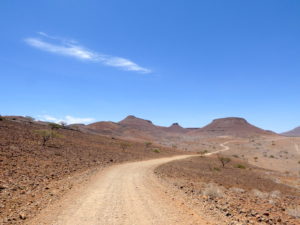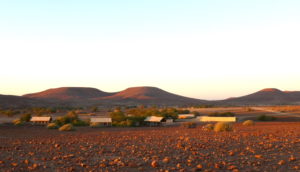
Faszination Wüste – Rhino Tracking in Namibia
4. Januar 2017
Blätterseife und Tee aus Sträuchern – die Eco Safari war spitze
10. Januar 2017John tells us not to move as the black rhino is trying to find our scent. Although as long as the wind blows into the right direction, there is no reason to worry. Still, my knees turn to jelly as the rhino is starring right at us from only a 45 metres distance, or so I thought.
I arrived at the Desert Rhino Camp at Palmwag Concession the night before, after a bumpy ride across the red stony desert, whose only green spots were a couple of acacias and round succulents. The sun coloured rJohn tells us not to move as the black rhino is trying to find our scent. Early this morning we have joined the Rhino Desert Trust to explore rhino tracking in the desert. ound hills and table mountains into a bright red. A truly fascinating and surreal landscape. My eyes simply couldn’t get enough. About one hour into the bumpy ride, Petro stopped the car: “Pst, listen!” I did as I was told so but couldn’t hear anything. I looked at my guide confused. He was laughing. “Exactly. Take in the complete silence.“ This wondrous silence would accompany me for the next 3 days.
In the middle of this deserted wilderness, the tips of the safari tents popped up. I am amazed. How can one build up such a stylish oasis in the middle of nowhere? Not only is it lighted bright by Christmas decorations, but by the warm faces of the staff. I am welcomed very warmly and after a quick refreshment, start out with a safari in the private concession of the camp.
Dusk is making the landscape seem even more bizarre and Oryx antelopes, Namibia’s symbol, are posing for the perfect photograph. Two jackals are carefully exiting their ‘succulent cave’, a giraffe, a couple of springboks and a kudu are walking towards the horizon. If you expect to see a lot of animals here, you will be disappointed as there is very little to feed on in the dried out riverbeds. Nevertheless, a reverent silences fills up the Jeep, as our thoughts are drifting into vastness of the magnificent landscape.
In the evening, we are pampered with a delicious dinner in the wilderness and are given first instructions by the trackers of Desert Rhino Trust by the bonfire. They will look for fresh rhino tracks first thing in the morning. Once they have found some, we will join them and start our tracking adventure.
At 5 in the morning I wake up as the peaceful silence is suddenly erupted by a lion’s roar. I am wide awake now and ready for this adventure! Johannes, our guide, receive the first longed for information via the radio. Fog from the Skeleton Coast crawled into our camp at night, it is chilly in the open vehicle and the dew sparkles in the morning sun.
We meet the trackers at a dried out riverbed. It is not easy to find tracks on the stones and it is even more difficult to tell if they are fresh, we are told. The trackers try to find tracks in the sandy parts because here it is easier to tell whether the wind has already blown away the tracks or if the tracks have been stepped on by other animals.
We walk through the stony desert and with every step the anticipation grows. We realize that asides from feisty black rhinos, there could be lions near. Yet, it is way more exciting to do this on foot than driving, plus one feels much closer to nature.
Suddenly our tracker smiles and points towards the dried out riverbed, where a female rhino is standing and is looking up to us. Of course the rhino has already detected us, rhinos are almost blind but their hearing and smelling senses are very advanced instead. We are whispering and as long as the wind is blowing from the opposite direction, it’s safe to stay. The animals seems relaxed, so we get closer.
We are standing right opposite to the rhino now. The whole group doesn’t move and no one says a word. I can feel the adrenaline rushing through my veins, even though I know that the rhino can’t see me. Its ears are twitching and its nose is trying to find a scent. Where there was once a majestic horn on its head, a round lump is sitting. Due to the increasing rhino poaching, Namibia’s government decided to place the animals across the country and to remove their horns. The trackers confirm that these methods have helped to decrease poaching.
The best method however, is “many feet on the ground” they agree. The more movements there are in the wilderness by the trackers or the tourists, the harder it gets for the poachers. The animals just mustn’t be disturbed, as research has shown that it will lead to no offspring and to that the rhinos will migrate to quieter areas.
We seem to be doing everything right because after a short while No Worries, the rhino’s name, loses interest in us and lies down to take a nap. Now we know how she got her name! We take a couple of photographs before heading back to further adventures.
“That’s how it’s supposed to be,” Erik, one of the trackers of Desert Rhino Trust, tells us. “Rhinos value their peace and quiet and we want to them to have that. We are happy to see that more and more tourists are interested in our work and support us financially, but we have to be careful not to drive away the rhinos.” The trackers take turns to go into different areas, which has proven itself. They recognize their protégés right away. Some rhinos we can only approach from 200 metres away, before the rhinos will charge us.
During our lunch, we get a thorough look into the interesting yet challenging work of the foundation, trying to protect the last free living rhinos outside of a national park, which we encountered today. While sitting on the patio of my safari tent, I gaze into the vastness, filled with excitement and ready for my next adventure.
Tomorrow my journey continues in Damaraland, on the quest for desert elephants.
Want to track wild rhinos?
[imic_form form_email=““ form_title=“Please contact us for further information.“]























